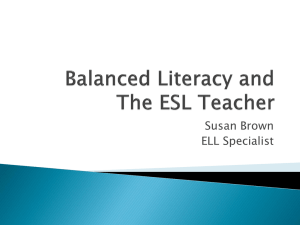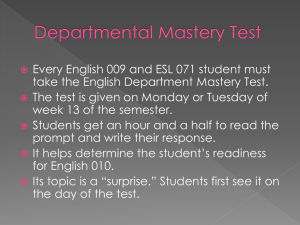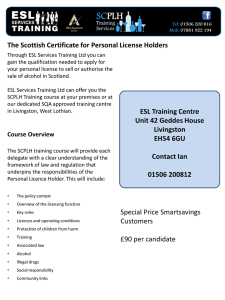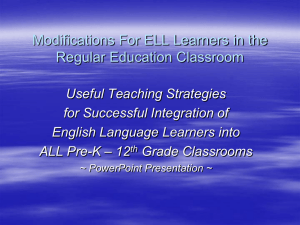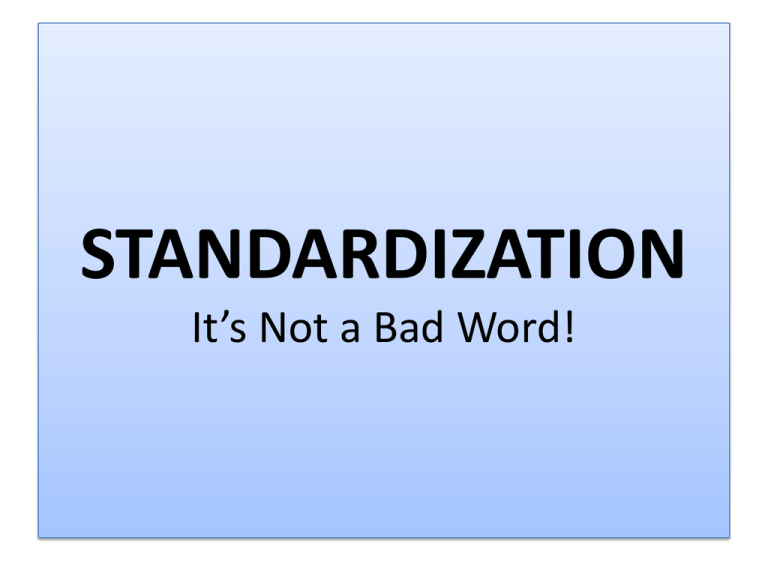
STANDARDIZATION
It’s Not a Bad Word!
Before Standardization
• Between 4 Adult Schools, CBET Classes and Offsite
Classes, ALL ESL classes had different curriculum,
timeline and content.
• Some classes didn’t use books, just worksheets.
• CASAS paired scores and benchmarks were minimal.
• Professional development was limited to back-toschool meeting, professional development day and
technology academy.
• No curriculum foundation on which to build and offer
professional development.
• Completion was based on subjective observation. No
standard for promotion.
ESL Core Text List
A
Oxford
Basic
Picture
Dictionary &
workbook
Foundations
1
Oxford Basic
Picture
Dictionary &
workbook
2
Oxford Picture
Dictionary &
Beginning
workbook
3
Oxford Picture
Dictionary &
Intermediate
workbook
4
Oxford Picture
Dictionary &
Intermediate
workbook
English No
Problem,
Literacy &
Workbook
Stand Out
Basic
English No
Problem 1
& Workbook
English No
Problem 2
& Workbook
English No
Problem 3
& Workbook
English No
Problem 4
& Workbook
Stand Out 1
Stand Out 2
Stand Out 3
Stand Out 4
Expressways 1 Expressways 2 Expressways 3 Expressways 4
Why Standardize?
• Mainstream curriculum for transient student
population.
• Consistency for students.
• Increase student outcomes and retention.
• Provide an constant academic base to ESL instruction.
• Establish a foundation of common goals between
adult schools and all ESL teachers.
• Establish teacher accountability for administrator
evaluation.
• Create professional learning communities in all
program areas.
Core Text Adoption
COMMITTEE SELECTION:
• Teachers were invited from each adult school, each
level, morning, afternoon and evening classes.
• Highly opinionated, highly critical, but strong
teachers were chosen for buy-in purposes.
• A total of 8 teachers selected, 2 from each adult
school
• Commitment of 1 year
• Teachers were paid to be on the committee through
our Workforce Investment Act (WIA) grant.
Core Text Adoption
TEXTBOOK EVALUATION:
• 5 Textbooks were selected by the ESL Resource Teacher for
committee evaluation and review.
• Criteria for evaluation was based on content, book layout and
organization, assessments, teacher’s edition, ancillaries,
CASAS competencies and alignment to ESL course outlines.
• Publishers gave a presentation – 1 every other week
• Teachers judged the textbook within their ESL level.
• Rubrics were created and used for evaluation.
• Teachers were given 3 hours of paid time for each book they
reviewed at home.
• Committee met each week to listen to the presentation and
then the following week, discuss their opinion of the
textbook.
ESL TEXTBOOK EVALUATION FORM
This form has been developed to assist you in reviewing textbooks for Adult Education ESL. Please rate the
various components on the scale of 1 to 5, with 1 being low and 5 being high.
The most effective way to do this would be to compare similar content chapters in each book. Use a separate
rating form for each text. These forms will assist you when choosing the text program that will best meet your
students needs and your needs.
Evaluator’s Name: ____________________________________________________________
Title of book and Publisher: _____________________________________________________
Level Evaluated: ____________________________________________________
CONTENT
Adult Appropriate layout (not childish)
1 . . . . . 2 . . . . . 3 . . . . . 4 . . . . . 5
Multicultural Selections
1 . . . . . 2 . . . . . 3 . . . . . 4 . . . . . 5
Alignment with district targeted standards
1 . . . . . 2 . . . . . 3 . . . . . 4 . . . . . 5
Visuals:
Pictures
1 . . . . . 2 . . . . . 3 . . . . . 4 . . . . . 5
Charts/Graphs
1 . . . . . 2 . . . . . 3 . . . . . 4 . . . . . 5
Diagrams
1 . . . . . 2 . . . . . 3 . . . . . 4 . . . . . 5
Language Use activities:
Listening Component
1 . . . . . 2 . . . . . 3 . . . . . 4 . . . . . 5
Speaking Component
1 . . . . . 2 . . . . . 3 . . . . . 4 . . . . . 5
Reading Component
1 . . . . . 2 . . . . . 3 . . . . . 4 . . . . . 5
Writing Component
1 . . . . . 2 . . . . . 3 . . . . . 4 . . . . . 5
Grammar Component
1 . . . . . 2 . . . . . 3 . . . . . 4 . . . . . 5
Word Study/Vocabulary
1 . . . . . 2 . . . . . 3 . . . . . 4 . . . . . 5
Readability
1 . . . . . 2 . . . . . 3 . . . . . 4 . . . . . 5
ORGANIZATION
Page layout
1 . . . . . 2 . . . . . 3 . . . . . 4 . . . . . 5
Relevant examples/applications
1 . . . . . 2 . . . . . 3 . . . . . 4 . . . . . 5
Activities
1 . . . . . 2 . . . . . 3 . . . . . 4 . . . . . 5
Writing Supports for targeted
1 . . . . . 2 . . . . . 3 . . . . . 4 . . . . . 5
ESL level writing genres
Accommodations for variety of learners
1 . . . . . 2 . . . . . 3 . . . . . 4 . . . . . 5
User friendly (student)
1 . . . . . 2 . . . . . 3 . . . . . 4 . . . . . 5
ASSESSMENT
Embedded assessment/reading checks
1.....2.....3.....4.....5
Variety of assessment formats
1.....2.....3.....4.....5
CASAS Assessment Type questions
1.....2.....3.....4.....5
Higher order questioning
1.....2.....3.....4.....5
Rubrics
1.....2.....3.....4.....5
TEACHER’S ANNOTATED EDITION
Clear explanations for teacher’s edition
1.....2.....3.....4.....5
Organization (useful and clear)
1.....2.....3.....4.....5
Usefulness (timelines, set up, hints)
1.....2.....3.....4.....5
Reference information for teacher
1.....2.....3.....4.....5
Correctness of answers
1.....2.....3.....4.....5
Variety/choice of activities
1.....2.....3.....4.....5
Overall – User friendly
1.....2.....3.....4.....5
Suggestions for how to teach our course
standards
Explicit connections made between standards
1.....2.....3.....4.....5
1.....2.....3.....4.....5
and texts used
ANCILLARIES (the goodies in the box!)
Transparencies
1.....2.....3.....4.....5
Audiovisual – laser disc, videos, tapes, CDs
1.....2.....3.....4.....5
Software support – dual platform
1.....2.....3.....4.....5
Test generators/test bank
1.....2.....3.....4.....5
Supplemental Materials
1.....2.....3.....4.....5
Support material for differentiated instruction
1.....2.....3.....4.....5
COMMENTS:
Include rationales for what you really liked or didn’t like.
_______________________________________________________________________________________
_______________________________________________________________________________________
Core Text Adoption
TEXTBOOK SELECTION:
• Selection had to be unanimous.
• Open discussion about pros and cons of each book.
• All materials available to be reviewed again.
• Public voting.
• Hang-up: Single vs Multi-level classes
• Solution: 2 different core textbooks – 1 for single
level and 1 for multi-level.
Core Text Staff Development
IMPLEMENTATION:
• Met with the Director of Adult Ed. and all administrators.
• Director sent out an email to all ESL teachers:
1.
2.
3.
4.
Introduction of the new Core Text
Expectations
Time Frame
Further details by ESL Resource Teacher
• Both publishers came back to provide staff development.
• Both publishers brought in current teachers from other agencies
who were using the textbook in their classes.
• All other textbooks were removed from the classrooms.
• Classroom sets of textbooks were cut back from 20 to 10.
• Expectations were clearly set by administrators and the ESL
Resource Teacher.
• Provided a platform for teachers to give constructive feedback.
• Paid observation time for teachers needing additional help.
• 90 minutes of class use per day.
Core Text Staff Development
ONGOING STAFF DEVELOPMENT:
• Constant reinforcement.
• Administrative support.
• Paid staff development throughout the year.
• Textbook author visit (2nd year of implementation to
address issues).
• Place for teachers to share successes and
constructive feedback.
• No hammer used/Gentle encouragement.
• Creation of the ESL Professional Learning
Community.
Professional Learning Community
DEFINITION:
“A Professional Learning Community, (PLC) is an
educational team committed to working collaboratively
in ongoing processes of collective inquiry and action
research to achieve better results for the students they
serve. PLC’s operate under the assumption that the key
to improved learning for students is continuous, job–
embedded learning for educators.”
Adapted from Learning by Doing by Dufour, DuFour, Eaker, Many
©2006
Professional Learning Community
COLLABORATIVE TEAMS FOCUSED ON LEARNING
The driving force of the collaborative culture of the
PLC is the team. Educators work together
interdependently in collaborative teams to achieve
common goals for which they are mutually
accountable. Teams work together to identify essential
learning, develop common assessments, analyze
student achievement data and support one another by
sharing strategies and material. Teams work together in
an ongoing effort to discover best practices and to
expand their professional expertise to improve student
learning outcomes.
Professional Learning Community
ESSENTIAL LEARNING
What do we want our students to learn? – YES
What do we want to teach our students? – NO
Essential knowledge/skills that teachers will ensure
all students will learn. The essential knowledge/skills
that teachers will continue to re-teach and re–assess
until they are learned. These are the essential learning
that a student MUST know to be successful at the next
level. The more specific the essentials, the better the
process of coordinating instruction, assessment, and
interventions. A student cannot pass to the next level
without the essential learning.
Professional Learning Community
PLC COORDINATOR TRAINING
• State level – CalPRO PLC Institute
• Administrator commitment
• Funding
COMMITTEE SELECTION:
• 2 Volunteers from each adult school.
• Preference for diversity in ESL levels and assignments.
• Ongoing commitment.
• Preference for those struggling to teach from the
core textbook.
Professional Learning Community
PLC GOALS:
• Identify Essential Learning for each chapter of each
textbook.
• Create a pacing guide for all teachers to use.
• Create assessments for each essential learning placed
on the pacing guide.
• Ongoing revision of both items.
• Continuous teacher feedback.
• Student centered curriculum based on teacher
observations.
Pacing Guides and Assessment
PACING GUIDES:
• Living and breathing document.
• Continuous feedback.
• Based on identified essential learning.
• Guide and not restrictive.
• Required for all ESL classes to follow.
• Used in teacher observations and evaluations.
ASSESSMENTS:
• Based on pacing guides.
• May need to revise existing assessments to include
essential learning.
• May need to revise orientation and intake process.
Assessment Sample
Side by Side Plus 3 – Unit 1
ESL Resource Website
Ongoing Staff Development
1. ESL Resource Website
2. Back to School Meeting
3. Professional Development Day
4. Special training as requested
5. ESL/ABE Summits
6. Onsite PLC teachers
7. Dedicated ESL Teacher on Special Assignment
8. Technology Academy
Ideal Process
1.
2.
3.
4.
Identify Essential Learning for each level of ESL.
Adopt a core textbook based on essential learning.
Create pacing guide for adopted core textbook.
Create assessments for each essential learning
identified.
5. Ongoing revision of pacing guides and assessments.
6. Data analysis through CASAS and course
completions.
7. Constant teacher feedback to the PLC committee
members for review.
PATIENCE! COMMITMENT! FAITH! MORE PATIENCE!



